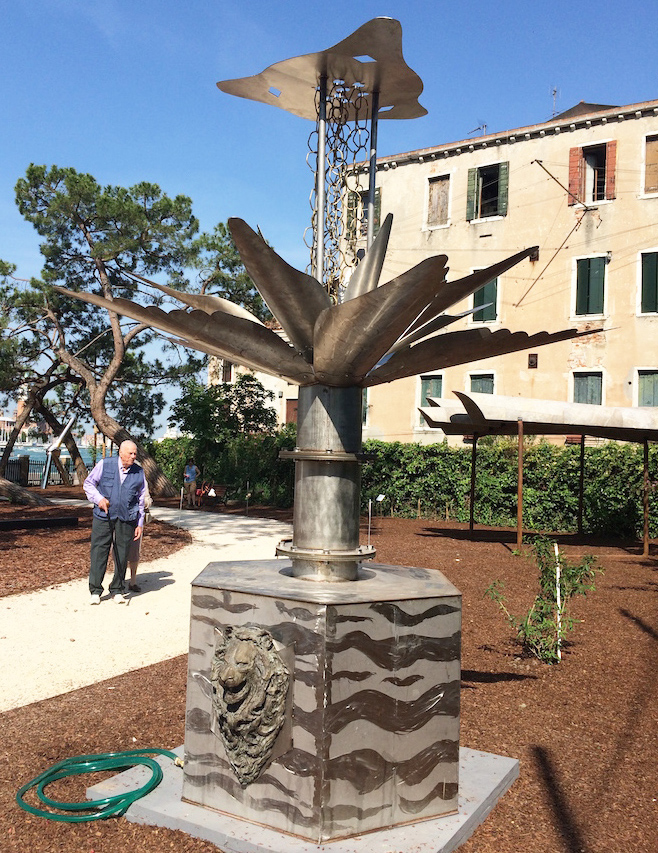A spring Architecture studio sheds light on collaborative place-making and green infrastructure while providing Providence with a much-needed solution to stormwater runoff.
Sculpting a Sustainable Future

As a grad student in Ceramics in the early 1980s, Allison Newsome MFA 83 CR says she was the only “nonfunctional ceramist” in the studio, using clay to make abstract pieces rather than bowls or other vessels.
Today she describes herself as a “functional sculptor,” working in her Warren, RI studio (a former lace factory) to design nature-inspired pieces that allow urban gardeners to capitalize on rainfall and turn off their taps. “That’s essentially my mission,” she explains: “to get everyone off treated, potable town water, which is not necessary for gardening.”
“I think of this work as utility sculpture— evocative in form and content but also utilitarian.”
Newsome’s patented, site-specific RainKeep designs are entirely passive—meaning there are no pumps or other moving parts to maintain. And in addition to collecting and storing thousands of gallons of water, they look intriguing and beautiful. “I think of this work as utility sculpture,” she says—“evocative in form and content but also utilitarian. Each one is designed to complement the landscape and any on-site buildings.”

Newsome’s foray into functional objects began in 2014 when she curated Water, Wind and Solar, a site-specific outdoor sculpture show at Blithewold Mansion, Gardens & Arboretum in Bristol, RI. The exhibition brought together exceptional work focused on the environment, but a preponderance of wind and solar pieces inspired her to fill the water gap herself—by making organic forms inspired by California redwoods, whose canopies catch coastal fog and direct it downwards to maintain the ecosystems below.
“I’m from the redwoods in northern California, where I worked for the Parks Department for seven summers,” Newsome says. “That’s where the concept originated.”
When members of the Bristol Garden Club saw the rain collectors she’d created out of clay, rubber and welded metal, they commissioned Whorl, a more permanent version for nearby Silver Creek Park. The piece catches rain at two levels—via upper and lower canopies—and uses decorative but functional steel chains to direct the water into the brushed steel storage vessel below. Powder-coated steel flowers ensure that no raindrops are left uncaught, and netting keeps mosquitoes and other insects out.

Newsome went on to design similar pieces for other outdoor gardens in New England as well as Vera da Pozza,a cast bronze version that mimics traditional Venetian wellheads. It was recently on view in Time Space Existence, a collateral exhibition of the 2018 Venice Biennale of Architecture hosted by the European Cultural Centre in Italy.
“The winged lion is the symbol of Venice,” the artist explains, “so I cast a lioness on one side and a male lion on the other.”

Newsome is showing the newest iterations of her design in the Innovators section of the Smart City Pavilion at Boston GreenFest & TechExpo (August 15–19), the biggest environmental festival of its kind in the Northeast. “I’m showing next to the newest electric car that gets 220 miles on a charge,” she notes, “and will meet all kinds of amazing innovators.” This fall she’ll also ship the piece to the 2019 Bioneers Conference in Marin County, CA, an October event sponsored by a sustainability nonprofit launched long before the word biomimicry was trendy.

When she’s not collaborating with fabricators and sustainable design innovators, Newsome continues to make nonfunctional sculpture in cast bronze and brass repose and to support Warren Cider Works, the bespoke beverage business recently launched by her husband, fellow RISD alum Spencer Morris BArch 79.
“I’m taking it all one day at a time,” says the levelheaded artist. “I learn something new from each piece I create and each person I collaborate with, and I’m really grateful for the support I’m getting from environmental organizations like The Nature Conservancy.”
—Simone Solondz
August 15, 2019

